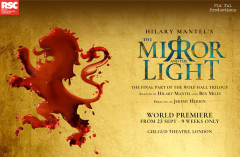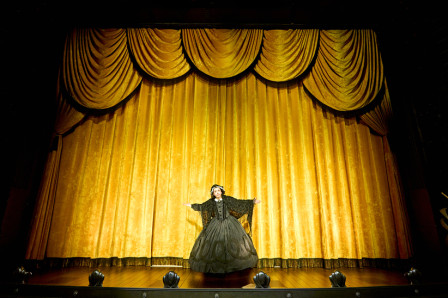Review: THE MIRROR AND THE LIGHT at the Gielgud Theatre
 The rich tapestry of British history, especially of the Royal Family, is fertile ground for writers, playwrights and filmmakers to plow. Hilary Mantel struck gold when she wrote three books on the lives and times of the Tudors, especially those of Henry VIII’s. The first two books, WOLF HALL and BRING UP THE BODIES were best sellers and the subsequent theatre adaptations of both books were equally successful. Now we have the final theatre adaptation of the Trilogy, THE MIRROR AND THE LIGHT. This final theatrical adaptation is a fitting and successful conclusion to the Trilogy.
The rich tapestry of British history, especially of the Royal Family, is fertile ground for writers, playwrights and filmmakers to plow. Hilary Mantel struck gold when she wrote three books on the lives and times of the Tudors, especially those of Henry VIII’s. The first two books, WOLF HALL and BRING UP THE BODIES were best sellers and the subsequent theatre adaptations of both books were equally successful. Now we have the final theatre adaptation of the Trilogy, THE MIRROR AND THE LIGHT. This final theatrical adaptation is a fitting and successful conclusion to the Trilogy.
The political, religious, sexual and relationship intrigues in Henry VIII’s court are so complicated that it would take several books and plays to cover all of it. The stories and intrigues of the Tudor are well documented and presented in countless books, television, film and stage productions. Hilary Mantel and Ben Miles wisely decided to concentrate on the rise and fall of Thomas Cromwell. We learn that Cromwell, through cunning maneuvering became the second most powerful man in England. This brought him lots of enemies, especially those of Thomas Howard and Archbishop Crammer. They managed to convince Henry with false evidence that Cromwell was plotting to take over the throne. This resulted in Cromwell being tried in private and sentenced to be hung drawn and quartered. Henry in a moment of “generosity” decided that he should be beheaded instead. Henry VIII’s presence in the play revolves around his quest for a male heir, for which he tries in vain with his wives, Jane Seymour, Anne of Cleves and Katherine Howard.
The authors choose to write dialogue in the vernacular and thus humanize
As with all RSC productions, the direction and acting are all excellent. Ben Miles (Thomas Cromwell) and Nathaniel Parker (Henry VIII) stand out from the rest ofthe excellent cast, in which Nick Woodeson (Thomas Howard) and Giles Taylor (Archbishop Cranmer) deserve special mention. The rich and beautifully designed period costumes help in the story telling as well as compensate for an almost bare stage set. Like his direction of the first two plays, Jeremy Herrin expertly directs each scene and situation with precision and economy.
This play is highly recommended to anyone wanting to have a cracking good yarn and a great evening at the theatre whilst learning something of British Tudor History.
Latest News

 Cast announced for Deep Azure at Shakespeare's Globe
12 December 2025 at 14:32
Cast announced for Deep Azure at Shakespeare's Globe
12 December 2025 at 14:32

 Production images released for Oh, Mary! West End premiere
12 December 2025 at 14:00
Production images released for Oh, Mary! West End premiere
12 December 2025 at 14:00

 Into the Woods at Bridge Theatre Review
12 December 2025 at 13:57
Into the Woods at Bridge Theatre Review
12 December 2025 at 13:57

 Review Round-Up: INTO THE WOODS at the Bridge Theatre
12 December 2025 at 13:05
Review Round-Up: INTO THE WOODS at the Bridge Theatre
12 December 2025 at 13:05
